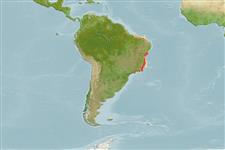Hexacorallia |
Scleractinia |
Faviidae
Environment: milieu / climate zone / Mức độ sâu / distribution range
Sinh thái học
Cùng sống ở rạn san hô; Mức độ sâu 0 - 30 m (Tài liệu tham khảo 848). Tropical; 1°S - 25°S, 45°W - 37°W (Tài liệu tham khảo 848)
Southwest Atlantic: Brazil.
Length at first maturity / Bộ gần gũi / Weight / Age
Chín muồi sinh dục: Lm ? range ? - ? cm
Formation: massive, less than 0.5 m across, usually flattened. Corallites: rounded, with thick walls, 10 to 15 mm in diameter. Septa: rounded, bead-like dentations only in living colonies. Color: browns and grays; corallite walls and centers often differently colored, commonly with radial stripes (Ref. 848).
Zooxanthellate (Ref. 121684). Occurs in shallow depths, tolerant of turbid environments (Ref. 848). On rocky reef (Ref. 121684).
Life cycle and mating behavior
Chín muồi sinh dục | Sự tái sinh sản | Đẻ trứng | Eggs | Sự sinh sản | Larvae
Members of the class Anthozoa are either gonochoric or hermaphroditic. Mature gametes are shed into the coelenteron and spawned through the mouth. Life cycle: The zygote develops into a planktonic planula larva. Metamorphosis begins with early morphogenesis of tentacles, septa and pharynx before larval settlement on the aboral end.
Bisby, F.A., M.A. Ruggiero, K.L. Wilson, M. Cachuela-Palacio, S.W. Kimani, Y.R. Roskov, A. Soulier-Perkins and J. van Hertum 2005 Species 2000 & ITIS Catalogue of Life: 2005 Annual Checklist. CD-ROM; Species 2000: Reading, U.K. (Tài liệu tham khảo 19)
IUCN Red List Status
(Tài liệu tham khảo 130435: Version 2025-1)
CITES status (Tài liệu tham khảo 108899)
CMS (Tài liệu tham khảo 116361)
Not Evaluated
Threat to humans
Human uses
| FishSource |
Các công cụ
Thêm thông tin
Sinh thái dinh dưỡngFood items (preys)
Thành phần thức ăn
Thành phần thức ăn
Các động vật ăn mồi
Population dynamicsSự sinh trưởng
Max. ages / sizes
Length-weight rel.
Length-length rel.
Length-frequencies
Mass conversion
Sự phong phú
Life cycleSự tái sinh sảnChín muồi sinh dụcSự sinh sảnĐẻ trứngEggsEgg developmentLarvae PhysiologyThành phần ô-xy
Human RelatedStamps, coins, misc.
Các nguồn internet
Estimates based on models
Preferred temperature
(Ref.
115969): 24.4 - 27.6, mean 26.8 (based on 123 cells).
Price category
Unknown.
